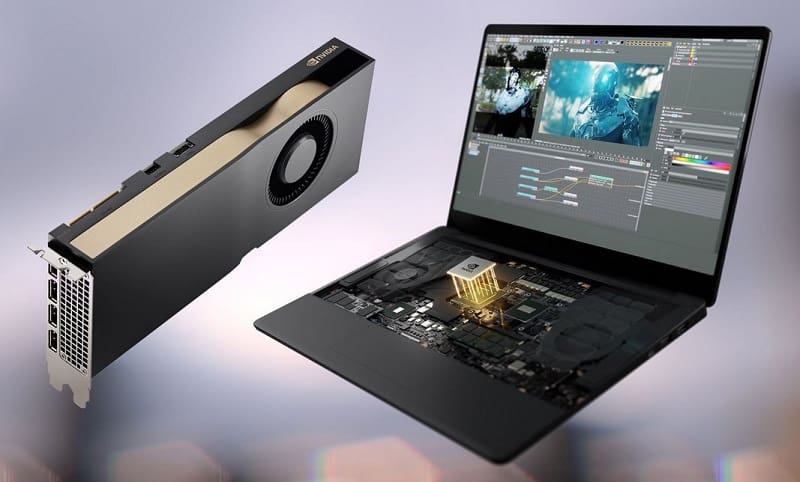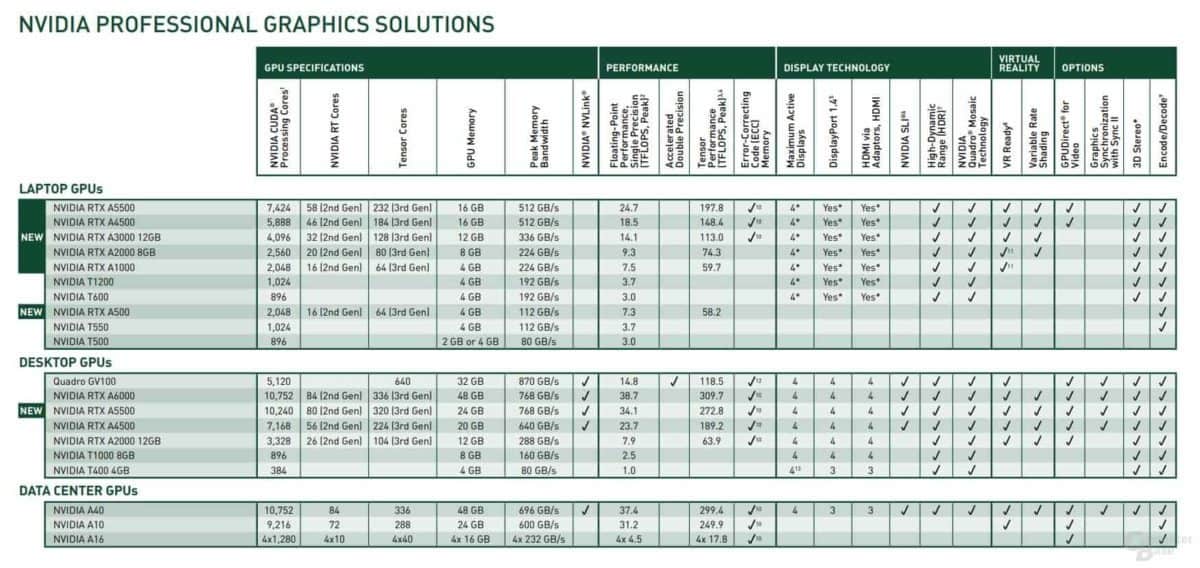New Nvidia RTX A5500, RTX A4500, RTX A1000 & RTX A500 workstation laptop GPU reveals
Replacements for RTX A5000 & RTX A4000 using new RTX 3080 Ti tech, plus other A-series upgrades

WePC is reader-supported. When you buy through links on our site, we may earn an affiliate commission. Prices subject to change. Learn more
The Nvidia RTX A5000 has been one of the most powerful workstation laptop GPU models available, and the new RTX A5500 is the latest flagship in the Nvidia RTX A-series range of laptop graphics cards, previously known as Nvidia Quadro. We also get a new A4500 addition to the SKU and refreshes of the existing RTX A3000 and A2000, but now with greater VRAM. More affordable options also come in by way of the new RTX A1000 and RTX A500 laptop graphics cards.
The following table, courtesy of computerbase.de, reveals the full specs of all the new Nvidia A-series workstation laptop graphics cards as well as their desktop GPU equivalents in a handy comparative table. We’ll summarise the main features you need to know about further down this page.

Nvidia RTX A5500 laptop vs RTX A5500 desktop
As you’d expect the RTX A5500 laptop version is less powerful than its desktop counterpart, coming with 7,424 CUDA cores compared to the 10,240, with a reduced power of 24.7 TFLOPS compared to the 34.1 TFLOPS of the desktop. VRAM is also reduced from 24GB to 16GB. The cores of both laptop and desktop versions, however, do use the same GA102 setup as found in the GPUs of RTX 3080 Ti laptops with improved Ray-Tracing technology for the RT-cores.
Nvidia RTX A5500 laptop vs RTX A5000 laptop
With 7424 CUDA cores in total, the RTX A5500 laptop GPU has 21% more compared to the 6144 of the RTX A5000 laptop GPU, along with the same increase in Nvidia RT cores for ray-tracing. According to Tom’s Hardware, this reportedly could lead to a potential 28% boost in FP32 performance. The RTX A5500 laptop version has the same 16GB of GDDR6 VRAM as the RTX A5000 laptop and the same 512 GB/s peak memory bandwidth, which indicates it’s also equipped with the same 256-bit memory interface.
Nvidia RTX A4500 laptop vs RTX A4000 laptop
With 5,888 CUDA cores, the RTX A4500 workstation laptop GPU has around 15% more than the earlier RTX A4000 laptop version, which had 5120. Once again the uplift of RT cores is also 15%, and once again the VRAM and memory bandwidth remain the same.
RTX A3000 12GB and RTX A2000 8GB laptop upgrades
The RTX A3000 and RTX A2000 are both existing laptop graphics cards, but these latest versions come with both more and faster VRAM. Both have doubled up in terms of the amount of memory to 12GB for the RTX A3000 and 8GB for the RTX A2000, with the peak bandwidth of the former increasing to 336 GB/s and the latter 224 GB/s.
New Nvidia RTX A1000 & RTX A500 GPUs
Finally, we have some new arrivals to the RTX A-series, both more budget-friendly offerings for the workstation laptop GPU market. The RTX A1000 and RTX A500 both have the same number of CUDA cores (2048) and amount of GDDR6 memory (4GB) however they differ in the amount of memory bandwidth and interface used. Whereas the RTX A1000 laptop graphics card gets a 128-bit memory interface and a peak bandwidth of 224 GB/s, the cheaper RTX A500 gets a 64-bit interface and a peak bandwidth of 12 GB/s.
New Nvidia RTX A-series workstation laptop GPU release date
Although we don’t have definitive release dates for each model at this moment, these latest workstation laptop GPUs from Nvidia will be released sometime in Spring, not long after the desktop version of the RTX A5500, which is available now.











